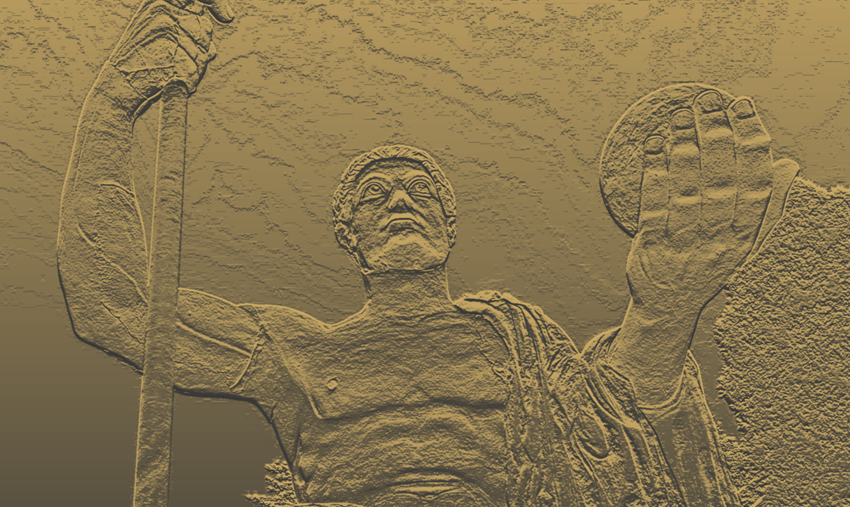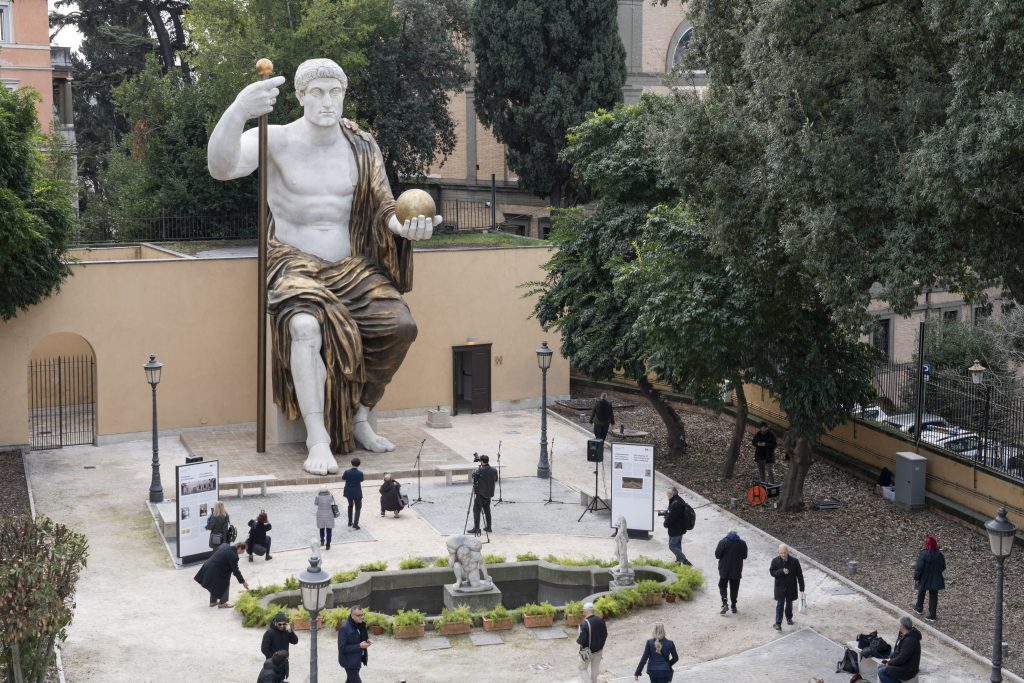Constant Carving
Thanks to a new statue, we remember a ‘Great’ emperor

Happy birthday, Constantine I! The enormously consequential Roman emperor was born 1,734 years ago today, in what’s now Serbia.
And only a few weeks ago, authorities in Rome unveiled a massive, 42-foot statue, a replica of an ancient one commissioned by Con-man himself back in 312 CE. Only nine original parts remained from the original Colossus of Constantine–the head and neck alone stand eight feet tall–but Madrid’s Factum Foundation managed to 3D-scan them and plausibly fill in the gaps. (Some things you have to take on faith.)

Rome’s Capitoline Gardens make an ironic location for the imposing statue, given that one of Constantine’s most famous moves was a literal move–out of Rome, eastward to a new capital he modestly named Constantinople. But he’s probably even more famous for something else …
Christianity and Controversy
Constantine grew up near his eventual capital, in Nicomedia (modern-day Izmit), where Christians faced fierce and unrelenting persecution. His push toward the Christian faith grew when he was emperor of Western Rome (the empire had been split by Diocletian)–specifically 312’s Battle of the Milvian Bridge, near Rome, where he fought co-emperor Maxentius. According to legend, Constantine saw a vision of the Christian cross in the sky on the eve of the battle. He went into battle under that banner, and achieved victory. (Some things you have to take on faith.)
In 313, Constantine and his eastern counterpart, Licinius, signed the Edict of Milan, proclaiming freedom of worship to all people and legalizing Christianity as a religion. Controversial on its face, it also ordered Roman citizens to return any property seized during recent persecutions. A decade later, even Licinius rethought the edict and resumed Christian persecutions. The ensuing civil war made Constantine the sole emperor, and united east and west under Christianity.
(Shortly thereafter his mother, Helena, took a trip to Jerusalem to rummage around for relics and pick the site of the Church of the Holy Sepulchre. To this day, many a cathedral houses a piece of the “True Cross” she brought back. Some things you have to take on faith.)
Needless to say, Constantine was a polarizing figure. On one hand, he was the righteous defender of Christianity, forbidding gladiatorial fights and crucifixion (though the latter was merely replaced with hangings). On the other hand, he retained an un-Christlike brutality, killing allies, friends, the families of already-dead opponents, and even his own family members. If you were a threat, or even seemed like someone who could conceivably become a threat, you were a goner.
Constantine was still in Rome all this time, but during the celebrations for the 20th anniversary of his reign, cracks opened along these religious and political fault lines. Constantine refused to take part in a pagan parade, offending the (other) Romans. Rather than do anything to patch up that situation, he rounded up his people and headed east to establish a “new Rome” on the Bosporus–a new Rome that bore his name for 1,600 years.
An end and a beginning
The Rome that Constantine left behind had wealth and prestige, but its importance was mostly nostalgic and symbolic. With its proximity to Persia, Constantinople better served the strategic needs of the empire. It was also legendarily defensible, sited as it was on an easily-walled peninsula; though the rest of the empire–which we’ve come to known as the Byzantine–was sacked by the Ottomans by the dawn of the 15th century, the capital held out until 1453.
But as far-reaching significance goes, the most important aspect of Constantinople was that its namesake could make it as Christian as he wanted. It’s no exaggeration to say that Christianity may not have survived at all without the guy; in religious circles, the officially-canonized saint is called “Constantine the Great,” and even “The Equal of the Apostles.”
The Roman Catholic and Greek Orthodox churches may still be officially split, but with Constantine’s new Capitoline statue, at least the old Roman Empire is that much closer to wholeness. (Some things you have to take on faith.)
When in Rome, make sure you take a selfie with his shin.
